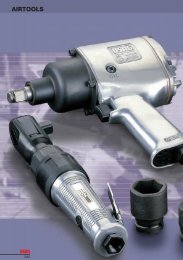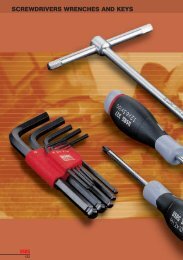Industrial seal self study guide - SKF.com
Industrial seal self study guide - SKF.com
Industrial seal self study guide - SKF.com
Create successful ePaper yourself
Turn your PDF publications into a flip-book with our unique Google optimized e-Paper software.
Chapter 4 Review<br />
To take this test, simply place a card or sheet of paper under the first question. After<br />
you’ve read it (and answered it to your<strong>self</strong>) slide the paper down below the next question.<br />
The correct answer to the first problem will appear directly to the right of the new<br />
question. Be sure not to skip any questions.<br />
1 . Simultaneous exclusion and retention is best performed with _________________ .<br />
❑ a. a <strong>com</strong>bination of two <strong>seal</strong>s back to back<br />
❑ b. single lip design <strong>seal</strong>s<br />
❑ c. a <strong>com</strong>bination of two <strong>seal</strong>s front to back<br />
❑ d. V-Ring <strong>seal</strong>s<br />
1. A<br />
2. _________________ is the most popular material for the majority<br />
of <strong>seal</strong>ing applications today.<br />
❑ a. Leather<br />
❑ b. Felt<br />
❑ c. Nitrile<br />
❑ d. Silicone<br />
3. Polyacrylates _________________ .<br />
❑ a. are <strong>com</strong>patible with high operating temperatures<br />
❑ b. offer high resistance to oxidation and ozone<br />
❑ c. may be used with water<br />
❑ d. both a. and b.<br />
4. Before the invention of nitriles, _________________ was the most <strong>com</strong>mon<br />
<strong>seal</strong>ing element.<br />
❑ a. rubber<br />
❑ b. felt<br />
❑ c. leather<br />
❑ d. metal<br />
5. Popular <strong>seal</strong>ing lip synthetics in use today include _________________ .<br />
❑ a. nitriles<br />
❑ b. fluoroelastomers<br />
❑ c. fluoropolymer (PTFE)<br />
❑ d. all of the above<br />
6. Advantages of polyacrylates include _________________ .<br />
❑ a. good <strong>com</strong>patibility with most oils<br />
❑ b. high resistance of oxidation and ozone<br />
❑ c. better <strong>com</strong>patibility with high temperatures than nitrile<br />
❑ d. all of the above<br />
2. C<br />
3. D<br />
4. C<br />
5. D<br />
6. D<br />
44







